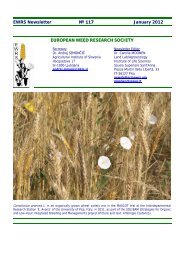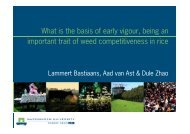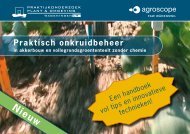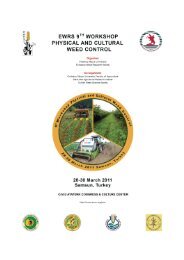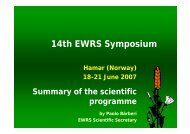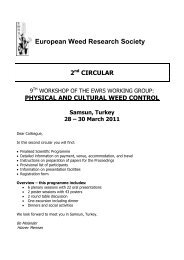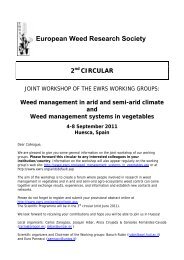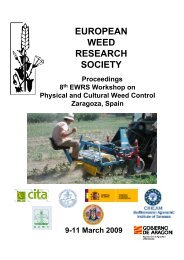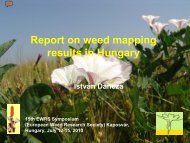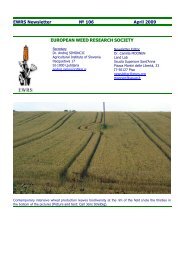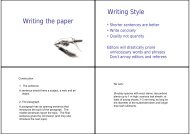3 rd Circular (pdf) - European Weed Research Society
3 rd Circular (pdf) - European Weed Research Society
3 rd Circular (pdf) - European Weed Research Society
Create successful ePaper yourself
Turn your PDF publications into a flip-book with our unique Google optimized e-Paper software.
<strong>European</strong> <strong>Weed</strong> <strong>Research</strong> <strong>Society</strong><br />
3 RD CIRCULAR<br />
8 TH WORKSHOP OF THE EWRS WORKING GROUP:<br />
PHYSICAL AND CULTURAL WEED CONTROL<br />
Dear Colleague,<br />
In this thi<strong>rd</strong> circular you will find:<br />
Zaragoza, Spain<br />
9-11 March 2009<br />
• Finalised Scientific Programme<br />
• Detailed information on payment, venue, accommodation, and travel<br />
• Instructions on preparation of papers for the Proceedings<br />
• Provisional list of participants<br />
• Information on presentation facilities<br />
• Registration form<br />
Overview – This programme includes:<br />
• Four plenary sessions with 20 oral presentations<br />
• One keynote session on “Physical and preventive weed control in uncultivated<br />
areas” (4 presentations)<br />
• Two poster sessions with 37 posters<br />
• Three round table discussion<br />
• One excursion including dinner<br />
• Dinners and social activities<br />
We look forwa<strong>rd</strong> to meet you in Zaragoza, Spain.<br />
Bo Melander<br />
Alicia Cirujeda<br />
Carlos Zaragoza<br />
1
Workshop programme - Overview<br />
Sunday 8 March<br />
17.00 Afternoon and Evening: Registration<br />
20.00 Welcome drink<br />
Monday 9 March<br />
09.00 Registration<br />
09.30 Opening address<br />
09.50 Session 1 – Preventive and cultural methods (3 presentations)<br />
11.00 Coffee<br />
11.20 Session 2 - Preventive and cultural methods (continuing) (6 presentations)<br />
13.30 Lunch<br />
14.30 Session 3 - Poster session incl. coffee (19 posters)<br />
16.30 Session 4 – Keynote theme: Physical and preventive weed control in uncultivated<br />
areas (4 presentations)<br />
18.30 End of first day’s scientific programme<br />
20.00 Guided tour of Zaragoza (to be determined). Afterwa<strong>rd</strong>s, dinner or tapas in the<br />
city centre<br />
Tuesday 10 March<br />
09.00 Session 5 - Mechanical weed control (7 presentations)<br />
11.20 Discussion<br />
11.30 Session 6 - Round-table discussions incl. coffee (3 round-tables)<br />
13.30 Lunch<br />
14.30 Excursion to conventional and organic farms<br />
20.00 Dinner at a local place<br />
Wednesday 11 March<br />
09.30 Session 7 - Report from round table discussion<br />
10.15 Session 8 - Poster session (16 posters)<br />
12.00 Session 9 -Thermal weed control (4 presentations)<br />
13.20 Discussion<br />
13.45 Lunch and end of workshop<br />
2
Full Programme – EWRS Workshop, Zaragoza, 2009<br />
Sunday 8 March<br />
17.00 Registration<br />
20.00 Welcome drink – we will inform you in due time where it will be held<br />
Monday 9 March<br />
09.00 Registration<br />
09.30 Opening address<br />
Bo Melander, coo<strong>rd</strong>inator and scientific organiser<br />
Alicia Cirujeda & Carlos Zaragoza, local organising committee<br />
Session 1 – Preventive and cultural methods<br />
Chair: Husrev Mennan (TUR)<br />
09.50 Integrated winter/summer cover crops into weed management program in<br />
organically grown vegetables, Husrev Mennan (TUR)<br />
10.10 Initial trials of a crimper-roller for killing cover crops for organic and non-herbicide,<br />
no-till cropping, Charles Merfield (IRL)<br />
10.30 Effects of cereal rye mulch and soybean density on weed suppression, Matthew<br />
Ryan (USA)<br />
10.50 General discussion<br />
11.00 Coffee<br />
Session 2 – Preventive and cultural methods (continued)<br />
Chair: Anne Légère (CAN)<br />
11.20 Combining enhanced competition and cultivation for improved weed control in<br />
organic cereals, Lauren Kolb (USA)<br />
11.40 The relative importance of cultural weed control methods: A survey of results from<br />
western Canada, Steve Shirtliffe (CAN)<br />
12.00 Mechanical barriers for yellow nutsedge (Cyperus esculentus) control in strawberry,<br />
Oleg Daugovish (USA)<br />
12.20 An integrated physical approach to control purple nutsedge (Cyperus rotundus),<br />
Joseph Hershenhorn (ISR)<br />
3
12.40 Effect of innovative crop and weed management systems on organic cauliflower in<br />
Central Italy, Stefano Carlesi (ITA)<br />
13.00 Non-chemical weed control with mulches and disks for nursery container<br />
production, Mario Lanthier (CAN)<br />
13.20 Discussion<br />
13.30 Lunch<br />
Session 3 – Poster session incl. coffee (19 posters)<br />
14.30 Introduction to posters by session chairs<br />
Posters 1 – 9 introduced by Baruch Rubin (ISR)<br />
Posters 10 – 19 introduced by Anne Légère (CAN)<br />
15.00 Poster presentations<br />
Session 4 - Keynote theme: Physical and preventive weed control in<br />
uncultivated areas<br />
Chair: Bo Melander, DNK<br />
16.30 <strong>Weed</strong> occurrence on pavements in five <strong>European</strong> towns, (20 min. presentation + 5<br />
min. discussion), Bo Melander (DNK)<br />
16.55 Results and experiences with physical weed control on ha<strong>rd</strong> surfaces (30 min.<br />
presentation + 5 min. discussion), David Hansson (SWE)<br />
17.30 Experiences with physical weed control on ha<strong>rd</strong> surfaces in central Italy (20 min.<br />
presentation + 5 min. discussion), Andrea Peruzzi (ITA)<br />
17.55 The invasion of weeds in the archaeological sites and innovated methods for their<br />
Control (30 min. presentation + 5 min. discussion), Garifalia Economou (GRC)<br />
18.30 End of first day’s scientific programme<br />
20.00 Guided tour of Zaragoza (to be determined). Afterwa<strong>rd</strong>s, dinner or tapas in the city<br />
centre<br />
4
Tuesday 10 March<br />
Session 5 – Mechanical weed control<br />
Chair: Ilse A. Rasmussen (DNK)<br />
09.00 Morphological differences between carrot and weeds: its usefulness in selective<br />
mowing as a weed control technique, Diane Lyse Benoit (CAN)<br />
09.20 The use of flex-tine harrow, torsion weeder and finger weeder in Mediterranean<br />
crops, Alicia Cirujeda (ESP)<br />
09.40 Sensor based selective weed harrowing in cereals, Victor Rueda Ayala (GER)<br />
10.00 Physical weed control in protected leaf-beet in Central Italy, Michele Raffaelli (ITA)<br />
10.20 Performance of a min-till rotary hoe in field pea (Pisum sativum), Eric Johnson<br />
(CAN)<br />
10.40 <strong>Weed</strong> patchiness: implications for physical and cultural control, Cesar Fernandez-<br />
Quintanilla (ESP)<br />
11.00 New innovations for intra-row weed control, Pieter Bleeker (NLD)<br />
11.20 Discussion<br />
Session 6 – Round-table discussions incl. coffee<br />
11.30 3 round tables<br />
1) Unifying parameters in mechanical weed control research and in practise, lead by<br />
Jesper Rasmussen (DNK)<br />
2) Unifying parameters in thermal weed control research and in practise, lead by<br />
Daniel Cloutier (CAN) & Johan Asca<strong>rd</strong> (SWE)<br />
3) Relevant and non-relevant parameters when studying cover crop and mulching<br />
effects, lead by Eric Gallandt (USA)<br />
13.30 Lunch<br />
Excursion<br />
14.30 Departure<br />
Afternoon: Field visits to an organic vegetable producer, to an organic wheat<br />
and bread producer of an ancient wheat variety and to an olive farm<br />
in the surroundings of Zaragoza<br />
Evening: Dinner at a local place<br />
5
Wednesday 11 March<br />
Session 7 – Report from round table discussions<br />
9.30 Unifying parameters in mechanical weed control research and in practise, lead by<br />
Jesper Rasmussen (DNK)<br />
9.45 Unifying parameters in thermal weed control research and in practise, lead by<br />
Daniel Cloutier (CAN) & Johan Asca<strong>rd</strong> (SWE)<br />
10.00 Relevant and non-relevant parameters when studying cover crop and mulching<br />
effects, lead by Eric Gallandt (USA)<br />
Session 8 – Poster session (17 posters)<br />
10.15 Introduction to posters by session chairs<br />
Posters 20 – 28 introduced by Ilse A. Rasmussen (DNK)<br />
Posters 29 – 37 introduced by Andrea Peruzzi (ITA)<br />
10.30 Poster presentations<br />
Session 9 – Thermal weed control<br />
Chair: Andrea Peruzzi (ITA)<br />
12.00 Thermal weed control - a review of current techniques, Johan Asca<strong>rd</strong> (SWE)<br />
12.20 Crop tolerance to flaming, Stevan Knezevic (USA)<br />
12.40 Solarization as a tool for non-chemical weed management, Baruch Rubin (ISR)<br />
13.00 <strong>Weed</strong> control with steam and solarization for field grown flower and strawberry,<br />
Steve Fennimore (USA)<br />
13.20 Discussion<br />
13.30 Concluding remarks and working group affairs, Bo Melander (DNK), Alicia Cirujeda<br />
(ESP) and Carlos Zaragoza (ESP)<br />
13.45 Lunch and end of workshop<br />
6
POSTERS<br />
Section 1. Chair: Baruch Rubin (ISR) (rubin@agri.huji.ac.il)<br />
1 Comparison of three tillage intensities on grass weed occurrence in cereal rotation,<br />
Jukka Salonen (FIN)<br />
2 Using ecological processes to manage cropping systems for weed suppression and<br />
other services in the U.S. corn belt, Matt Liebman, Paula R. Westerman, Andrew H.<br />
Heggenstaller, and Brent J. Danielson (USA)<br />
3 <strong>Weed</strong> suppression by canola and musta<strong>rd</strong> cultivars, Hugh J. Beckie, Eric N.<br />
Johnson, Robert E. Blackshaw, and Yantai Gan (CAN)<br />
4 Control of weeds in flooding rice through non-chemical methods, Taberner A.,<br />
Consola S. Llenes JM, Roque A. (ESP)<br />
5 Evaluation of different mulches for weed control in processing tomato, A. Cirujeda,<br />
J. Aibar, A. Anzalone, M. Gutierrez, S. Fernández-Cavada, A. Pa<strong>rd</strong>o, Mª L. Suso, A.<br />
Royo, L. Martín-Closas, J- Costa, A. M. Pelacho, M.M. Moreno, A. Moreno, R. Meco,<br />
I. Lahoz, J.I. Macua, C. Zaragoza (ESP)<br />
6 Possibilities to use musta<strong>rd</strong> (Sinapis alba) meal for weed control, Fredrik Fogelberg<br />
(SWE)<br />
7 <strong>Weed</strong> population dynamics in fields with different management, Piliksere Dace<br />
(LVA)<br />
8 Effect of Cirsium arvense and Elymus repens on yield of winter wheat, spring barley<br />
and faba bean in an organic crop rotation experiment, Ilse A. Rasmussen (DNK)<br />
9 Effect of soil tillage systems on the control of perennial weeds in a fluvisol, T. Rusu,<br />
P. Gus, I. Bogdan, P. I. Moraru, A.I. Pop, I. Pacurar, H. Cacovean and D. Clapa<br />
(ROU)<br />
Section 2. Chair: Anne Légère (CAN) (legerea@agr.gc.ca)<br />
10 Reduced rate of herbicide in corn by using different planting methods, Eskandar<br />
Zand, Mohammad Ali Baghestani Mohammad Sarhaddi & Ali Eskandari (IRN)<br />
11 Influence of plant densities of two barley (Ho<strong>rd</strong>eum vulgare L.) varieties on wild oat<br />
(Avena fatua L.), Adel Dabbagh Mohammadi Nassab, Ismaeel Mohammadi<br />
Bilankohi, Aziz Javanshir , Elnaz Ebrahimi Mollabashi (IRN)<br />
12 Flag leaf area and chlorophyll content of wild oat (Avena fatua L.) influence by<br />
different plant densities of two barley (Ho<strong>rd</strong>eum vulgare L.) varieties, Ismaeel<br />
7
Mohammadi Bilankohi, Elnaz Ebrahimi Mollabashi, Adel Dabbagh Mohammadi<br />
Nassab, Aziz Javanshir, Bahram Mirshekari (IRN)<br />
13 Managing weed seed rain to enhance physical weed control efforts, Eric Gallandt<br />
(USA)<br />
14 Dissecting IWM: the contribution of cultural control to the success of IWM in Prairie<br />
cropping systems, AG Thomas, J Leeson, FA Holm, B Gradin, CS Stevenson (CAN)<br />
15 In pursuit of effective mechanical/physical weed management in organic lo-till, W.<br />
Curran, R. Bates, S. Mirsky, R. Gallagher, D. Mortensen, and M. Ryan (USA)<br />
16 Non-chemical weed control on open-field fresh market tomato in the Serchio Valley<br />
(Central Italy), Fontanelli M., Raffaelli M., Ginanni M., Lulli L., Frasconi C., Sorelli F.,<br />
Peruzzi A. (ITA)<br />
17 Comparison of several recommended cultural practices for weed management and<br />
their effects on yield of coconut in tropical coconut plantations, S.H.S.Senarathne<br />
and M.J.I.Costa (LKA)<br />
18 Innovative operative machines for physical weed control on organic cauliflower in<br />
Central Italy, Fontanelli M., Frasconi C., Lulli L., Sorelli F., Carlesi S., Bigongiali F.,<br />
Antichi D. & Peruzzi A. (ITA)<br />
19 Management issues related to the use of the herbicide glyphosate and the<br />
transformations operated by urban vegetation in Genoa (Northern Italy). First note,<br />
Alessandra Di Turi (ITA)<br />
Section 3. Chair: Ilse A. Rasmussen (DNK) (ilsea.rasmussen@agrsci.dk)<br />
20 Using the spring-tine harrow in a navy bean crop (Phaseolus vulgaris var. Tabella<br />
Brisa) for human intake, Taberner A., Llenes JM, Roque A. (ESP)<br />
21 Using the spring- tine harrow in a crop of Amaranthus sp. for grain production,<br />
Taberner A., Zamora N., Llenes JM, Roque A. (ESP)<br />
22 Current weed management and the problem of the highly adaptive, cosmopolitean<br />
weeds, L. Radics and M. Glemnitz (HUN)<br />
23 Evaluation of Finger and Torsion <strong>Weed</strong>ers for Cultivating Cool Season Vegetables in<br />
Salinas, CA, USA, R.F. Smith, M. Silva Ruiz (USA)<br />
24 Physical weed control on cabbage in the Serchio Valley (Central Italy), Fontanelli<br />
M., Raffaelli M., Ginanni M., Lulli L., Frasconi C., Sorelli F., Peruzzi A. (ITA)<br />
25 Innovative operative machines for physical weed control on processing tomato in<br />
the Serchio Valley (Central Italy), Fontanelli M., Raffaelli M., Ginanni M., Lulli L.,<br />
Frasconi C., Sorelli F., Peruzzi A. (ITA)<br />
8
26 False seedbeds in organic grown winter wheat, Arnd Verschwele (DEU)<br />
27 Autonomous navigation in weed-infested maize fields. Abadia D., Ballano S., Uson<br />
F., Paniagua J., Seco T., Cirujeda A., Zaragoza C. (ESP)<br />
28 Vision based crop plant identification for weeding operations. Abadia D., Gonzalez<br />
S., del-Hoyo R., Paniagua J., Seco T., Cirujeda A., Zaragoza C. (ESP)<br />
Section 4. Chair: Andrea Peruzzi (ITA) (aperuzzi@agr.unipi.it)<br />
29 Using cultural methods for controlling weeds in corn and reducing herbicide rate,<br />
Mohammad Ali Baghestani Maybodi, Eskandar Zand, and Arash Roozbehani (IRN)<br />
30 Identifying weed distribution using soil properties, Hamid Salehian and Saeid Soltani<br />
(IRN)<br />
31 Is ya<strong>rd</strong>waste mulch a weed-free substrate?, Oleg Daugovish, James Downer , Ben<br />
Faber (USA)<br />
32 <strong>Weed</strong> tolerance to flaming, Stevan Z. Knezevic Santiago Ulloa (USA)<br />
33 Corn types differ in their response to broadcast flaming, Stevan Z. Knezevic, Claudio<br />
Martin da Costa, Santiago Ulloa and Avishek Datta (USA)<br />
34 Winter wheat (Triticum aestivum L.) tolerance to broadcast flaming, Stevan Z.<br />
Knezevic, Jaymo Ferrari Neto, Santiago Ulloa and Avishek Datta (USA)<br />
35 Dose-response of weeds to flaming, Leblanc, M.L., Cloutier, D.C., Sivesind, E.,<br />
Stewart, K.A. (CAN)<br />
36 Effects of soil steaming on weed seed viability, Francesco Vidotto; Marilisa Letey;<br />
Davide Ricauda-Aimonino (ITA)<br />
37 Liquefied Petroleum Gas (Propane + Butane) as a new physical method to control<br />
weed, turfgrass and pest in olive (Olea europaea) trees. JM. Durán, R. Moratiel, N.<br />
Retamal, E. Pombo, I. Santiago (ESP)<br />
IMPORTANT<br />
Poster presenters must send a maximum of two PowerPoint slides to the<br />
relevant session chair BEFORE March 1 st 2009 (their emails are besides their<br />
names in the programme). Their posters will only be introduced if they have<br />
sent it in time.<br />
The slide MUST contain:<br />
• Poster number acco<strong>rd</strong>ing to the number in the programme<br />
• The title<br />
9
• Name(s) of authors incl. country codes. If more than two authors use: et<br />
al.<br />
• Objective of the work<br />
• Main results and conclusions<br />
Detailed information<br />
REGISTRATION<br />
Please note that the final deadline for us to receive your payment is January<br />
15, 2009.<br />
Please fill-in the online form to confirm your payment. The link to the form is in the<br />
Physical and Cultural <strong>Weed</strong> Control web site at: www.ewrs.org/pwc. Send the form only<br />
after having paid your registration fee.<br />
The registration fee will cover the costs for the welcome drink on Sunday, the meeting’s<br />
booklet with abstracts and folders, facilities, excursion on Tuesday, coffee-breaks and<br />
lunches (Monday to Wednesday), and dinner on Tuesday, following the excursion.<br />
Fee for EWRS-members and students paid before 15 December 2008: 150 Euro<br />
Fee for non EWRS-members paid before 15 December 2008: 205 Euro<br />
Fee for EWRS-members and students paid after 15 December 2008: 180 Euro<br />
Fee for non EWRS-members paid after 15 December 2008: 235 Euro<br />
Credit ca<strong>rd</strong> payments cannot be accepted. Please pay the registration fee to the following<br />
bank account:<br />
Account Name: Meeting WG PCWC Zaragoza 2009<br />
Account Number: 2086-0047-34-3300109336<br />
Bank: Caja Inmaculada<br />
IBAN: ES58-2086-0047-3433-0010-9336<br />
BIC/SWIFT: CECAESMM086<br />
Address of the bank: Avda. de Cesáreo Alierta, nº 19 -21, 50008 Zaragoza,<br />
Aragón, Spain<br />
Telephone number of the bank: 976.59.69.60; Fax: 976.59.68.94<br />
IMPORTANT<br />
Please add "EWRS Workshop 2009 Zaragoza" for payment identification. Bank<br />
transaction fees have to be paid by the participants.<br />
VENUE<br />
The Workshop meetings will take place on the Campus of Aula Dei, located 17 km from<br />
the centre of Zaragoza. Zaragoza, a 2000-year-old city with 700.000 inhabitants, is<br />
architecturally very interesting, especially from its Arabic period. The city is located next to<br />
the Ebro river, which defines the landscape of the ‘Ebro valley’, an important agricultural<br />
10
egion. This is an area of large contrasts between the irrigated valley and the arid<br />
surroundings with little vegetation. Zaragoza is located between Madrid and Barcelona,<br />
approximately 300 km from each. It is serviced directly by a few airlines and there are fast<br />
and frequent trains from both Madrid and Barcelona. Zaragoza’s central location offers an<br />
excellent opportunity for you to spend some extra days visiting the two major cities of<br />
Spain, Barcelona and Madrid, with all their interesting attractions.<br />
Several institutions are located on the Aula Dei Campus: The Centro de Investigación y<br />
Tecnología Agroalimentaria (CITA) (a regional <strong>Research</strong> Centre in Food and Agriculture), a<br />
delegation of the Consejo Superior de Investigaciones Científicas (CSIC) (the main<br />
<strong>Research</strong> Institution of Spain), the Plant Protection Service and different laboratories of<br />
the Agriculture Department of Aragón and the Instituto Agronómico Mediterráneo de<br />
Zaragoza (IAMZ), the latter is providing the facilities for our meeting.<br />
ACCOMMODATION AND TRANSPORT TO THE CAMPUS<br />
Participants in the workshop will have lunch at the Campus restaurant. Accommodations<br />
will be in Zaragoza, and a list of recommended hotels in the city centre is provided below.<br />
The central location of the hotels will encourage meeting after the official programme. We<br />
hope that informal discussions will continue while enjoying some ‘tapas’ in many of the<br />
bars of the old city.<br />
We recommend staying at one of the hotels in the city centre as we will provide transport<br />
to the Campus. The listed hotels are very close to each other. There will be a limited<br />
number of stops to pick up the participants, probably at the Coso or Avda. César Augusto<br />
road and at the Echegaray y Caballero road. We will decide the definitive stops depending<br />
on the location of the chosen hotels. Therefore, PLEASE SEND US THE NAME OF<br />
YOUR HOTEL AS SOON AS YOU HAVE BOOKED IT (mleonn@aragon.es) so that we<br />
can select the final stops. We will inform you of the definitive route in due time.<br />
Here is a list of recommended hotels in the city centre listed from lower to higher category<br />
with updated prices. Vía Romana and Tibur are next to each other. When contacting the<br />
hotels, please indicate that you are a participant in the Working Group Meeting to obtain<br />
lower prices:<br />
- Zaragoza hostel<br />
Calle Predicadores 70;<br />
Tlf.: (+34) 976.48.15.68<br />
http://www.alberguezaragoza.com<br />
16.60-21.60€ without breakfast<br />
- Hotel Río Arga **<br />
Calle Contamina 20;<br />
Tlf.: (+34) 976. 39.90.65<br />
http://www.hotelrioarga.es<br />
43€ single room, 60€ double room<br />
- Hostal Santiago ***<br />
Calle Santiago 3;<br />
Tlf.: (+34) 976. 39.45.50<br />
http://www.hostalplaza-santiago.com<br />
45€ double room<br />
11<br />
- Hotel Husa Vía Romana ***<br />
Calle Don Jaime 154-156;<br />
Tlf.: (+34) 976. 39.82.15<br />
http://www.hotelhusaviaromana.com<br />
60-80€ single room<br />
- Hotel Tibur***<br />
Plaza de la Seo 2 y 3<br />
Tlf.: (+34)976.20.20.00<br />
http://www.hoteltibur.com<br />
80€ double room<br />
- Hotel Oriente ****<br />
Calle Coso 11;<br />
Tlf.: (+34) 976. 20.32.82<br />
http://www.hotel-oriente.com<br />
60-75€ + 10€ breakfast
DEADLINES<br />
15 th December 2008<br />
• Deadline for payment of the workshop fee<br />
12<br />
- Hotel Ramiro I ****<br />
Calle Coso 123<br />
Tlf.: (+34) 976. 29.82.00<br />
http://www.pretur.com/hotel_ramiro_i.php<br />
100€ single room, breakfast included<br />
120€ double room, breakfast included<br />
15 th January 2009<br />
• Deadline for submission of final abstracts (mandatory) and optional full papers for the<br />
Proceedings. Submissions will only be done online through the web site (see instructions at<br />
www.ewrs.org/pwc). Please note that you must resubmit your abstract and follow the<br />
instructions below. The link for uploading will be available starting December 8.<br />
ORGANISING COMMITTEE<br />
Organising committee:<br />
• Scientific organisers<br />
Bo Melander (Aarhus University, Faculty of Agricultural Sciences, Department of Integrated<br />
Pest Management, <strong>Research</strong> Centre Flakkebjerg, Denmark)<br />
Alicia Cirujeda & Carlos Zaragoza (Centro de Investigación y Tecnología Agroalimentaria<br />
(CITA), Zaragoza, Spain)<br />
Daniel Cloutier (Institut de malherbologie, Beaconsfield, Canada)<br />
• Local organisers<br />
Alicia Cirujeda & Carlos Zaragoza (Centro de Investigación y Tecnología Agroalimentaria<br />
(CITA), Zaragoza, Spain)<br />
Joaquín Aibar (Escuela Politécnica Superior de Huesca, University of Zaragoza, Spain)<br />
Sonsoles Fernández-Cavada (Centro de Protección Vegetal, Diputación General de Aragón,<br />
Zaragoza, Spain)<br />
• Chairman of the working group<br />
Bo Melander (Aarhus University, Faculty of Agricultural Sciences, Department of Integrated<br />
Pest Management, <strong>Research</strong> Centre Flakkebjerg, Denmark)
Appendix 1<br />
Abstracts are mandatory for all authors.<br />
Instructions for the preparation of<br />
abstracts and papers for the proceedings<br />
The final formatting and changes in font size for paragraphs and various headings will be done by<br />
the editor.<br />
General instructions:<br />
Wo<strong>rd</strong> processor: If at all possible, please submit your text in a PC compatible format, using<br />
either Wo<strong>rd</strong>Perfect for Windows (version 6 or up) or Microsoft Wo<strong>rd</strong> for<br />
Windows (.doc not .docx). Otherwise, save your text as a RTF file (rich text<br />
format).<br />
Paper format: A4 (210 x 297 mm)<br />
Page margins: 20 mm on every side except for the top where the margin is 30 mm<br />
Line spacing: Single space<br />
Font: Times New Roman<br />
Font size: 12 pt. everywhere in the text, including headings, title, etc. Text in the tables<br />
can be smaller to make it fit but no less than 8 pt. Superscript and subscript<br />
can be used anywhere.<br />
Text justification: Left justified everywhere, for all the text, title, authors, etc<br />
Page numbering: NONE<br />
Headers, footers: NONE<br />
Latin names: Use italics for Latin names. Do not underline. Use common names for crops<br />
and Latin names for weeds. Common names for weeds may be indicated in<br />
parenthesis after the first mention of the Latin binomial.<br />
Paragraphs: No indentation<br />
Between paragraphs: Insert a blank line between paragraphs<br />
Headings: Four levels of heading can be used. All in Times Roman at 12 pt.<br />
- The first level is bold, preceded and followed by a blank line<br />
- The second level is in italics, preceded by a blank line<br />
- The thi<strong>rd</strong> level is underlined, preceded by a blank line<br />
- The fourth level is underlined and in italics, preceded by a blank line<br />
Measurement units: Standa<strong>rd</strong> international units should be used<br />
Space preceding and following various headings: One blank line<br />
Insert only one single blank space after a full stop in a sentence.<br />
File name: Please note that you must use file names that are informative when<br />
submitting your abstract or full paper. When submitting your text, please<br />
use you name and use underscore ( _ ) between wo<strong>rd</strong>s. Example:<br />
Bo_Melander.doc. If you submit more than 1 file, use numbers. Example:<br />
Bo_Melander_1.doc, etc.<br />
Abstracts:<br />
Mandatory for all authors is the submission of a one-page abstract for each oral or poster<br />
presentation. These abstracts will appear in the ha<strong>rd</strong>-copy booklet that will be distributed at the<br />
13
workshop and also in the proceedings of the workshop. Your text must conform to the general<br />
instructions above and to the following instructions:<br />
Headings: No more than two levels<br />
Tables and figures: Should be avoided in the abstracts<br />
References: Maximum of three references should appear in the abstracts.<br />
See the example at the end of this Appendix.<br />
Full papers (optional):<br />
There is an example at the end of this Appendix.<br />
Authors who want to publish full papers are requested to upload their contributions no later than<br />
15 January 2009. These papers will appear in the proceedings which will be made available on the<br />
web. Papers received after 15 January 2009 will not appear in the Proceedings.<br />
The language for the texts will be English. The texts will not be refereed and therefore the author(s)<br />
must assume full responsibility for any errors or omissions. The maximum number of pages<br />
allowed for a manuscript is 15 pages (including tables, figures and pictures). The submitted paper<br />
must be formatted exactly as it is intended to appear, with the tables and figures included in the text.<br />
Left align everything, title, headings, etc.<br />
Title:<br />
Bold. Capitalise only the first wo<strong>rd</strong> and proper names in the title. Include only the scientific names<br />
of weeds and of uncommon crops in the title, but only the common names of well-known crops.<br />
Author(s):<br />
Skip one line after the Title. The author(s) list and affiliation/location are left aligned and in boldface.<br />
Use first name initials prior to family name (e.g. D.W.M. Pullen 1 and P.A. Cowell 2 ). Use the<br />
same numbers in superscript after family name to identify authors with same mailing address. On<br />
the line below the author’s name(s), when there is more than one author, put the number in<br />
superscript, followed by the author’s name of institution, city, country and email.<br />
Body of the text:<br />
Skip one line after the last author’s address. Main headings are left justified on one line in boldface.<br />
In Materials and methods, include location of manufacturers or suppliers with brand names.<br />
Discussion must incorporate conclusions. Skip one line before each heading and skip a line after<br />
each heading.<br />
Normally, main headings are:<br />
Abstract, Introduction, Material and Methods, Results, Discussion (or Results and discussion),<br />
Acknowledgements, References but other headings could be used if relevant.<br />
Standa<strong>rd</strong> international units (SIU) must be used. For SI usage see Standa<strong>rd</strong> Practice for Use of the<br />
International System of Units E380-91a, available from American <strong>Society</strong> for Testing and<br />
Materials, 1916 Race St., Philadelphia, PA 19103. Use mass rather than weight; use negative<br />
exponents for units in the denominator (e.g., kg m -2 ) and use L for litre (mL for millilitre).<br />
14
Use "Figure" only at start of sentence; otherwise "Fig." or "Figs."<br />
References: For reference citations, follow the <strong>Weed</strong> <strong>Research</strong> style<br />
Tables and figures:<br />
• Number tables and figures in Arabic followed by a full stop. Capitalise the first wo<strong>rd</strong> of the<br />
title; all others should be in lowercase unless a proper noun; place a full stop at the end of the<br />
table title.<br />
• Insert a blank line before and after a table or a figure.<br />
• The text in the tables should be no less than 8 pt. in size.<br />
• Tables should be made using the Table option of your wo<strong>rd</strong> processor rather than using spaces<br />
or tabs.<br />
• Capitalise the first wo<strong>rd</strong> of each entry in each column; do not use vertical lines; indicate<br />
footnotes by lowercase superscript letters.<br />
• Tables, figures and pictures should not exceed page margins (170 mm).<br />
For any queries about instructions, please contact Daniel Cloutier (pwc2009@ewrs.org)<br />
Example of an abstract<br />
(text truncated, used for illustration purposes only, one extra name<br />
was added after Pullen):<br />
Comparison of alternative interrow weeder steering systems<br />
D.W.M. Pullen 1 , A.N. Addedname 1 and P.A. Cowell 2<br />
1 Cranfield University at Silsoe, Silsoe, Bedfo<strong>rd</strong> MK45 4DT, UK Email: d.pullen@cranfield.ac.uk<br />
2 Consultant, formerly with Cranfield Univesity at Silsoe<br />
The success of interrow weeding depends on being able to quickly and accurately guide the weeder<br />
along the rows. This can only be done by automatically guiding the weeder. Any automatic weeder<br />
steering system requires a sensor/s to provide an error or guidance signal and a mechanism to move<br />
the hoes to the correct lateral position at the correct time ……….<br />
Results of the study show the modelling technique was accurate. The amplitude of the predicted<br />
weeder path was within 2% and the phase angle within 2 degrees of the actual value. 1The study<br />
also suggests fitting steered wheels, whose position moved proportionally with the error signal was<br />
overall the most suitable method of steering the weeder. For this steering system the model shows<br />
the critical parameters affecting overall performance were the steering gain and hoe position. The<br />
tractor type (ICR position), the sensing position, the steered wheel position and steered wheel axle<br />
position did not significantly influence performance. However, positioning the steered wheels<br />
behind the headstock but in front of the weeding blades would be better practically.<br />
References<br />
Pullen DWM and Cowell PA (2000). Prediction and experimental verification of a rear-mounted<br />
inter-row weeder. J. agric. Engng Res 77, (2) 137-153.<br />
Jahns G (1976). Automatic guidance of farm vehicles - a monograph. Agricultural Engineering<br />
Departmental Series No 1. Agricultural Experiment Station, Auburn University.<br />
15
Example of a full paper<br />
(text truncated, used for illustration purposes only):<br />
Analysis and definition of the close-to-crop area in relation to robotic weeding<br />
M. Nørremark and H.W. Griepentrog<br />
The Royal Veterinary and Agricultural University, Department of Agricultural Sciences /<br />
AgroTechnology, Copenhagen, Denmark<br />
Abstract<br />
The objective of this paper is to analyse and define the field conditions close to the crop plants of<br />
sugar beet (Beta vulgaris L.). The aim is to use this study for the choice and......<br />
Introduction<br />
So far, no commercial mechanical or physical method has been developed for highly selective<br />
control of weeds within the crop row. Concerning efficiency, the available.....<br />
[Plants m 100 -2 ]<br />
<strong>Weed</strong><br />
Density<br />
50<br />
0<br />
0 1 2 3 4 5 6 7 8 9 10 11 12 13 14<br />
Distance from crop plant<br />
[cm]<br />
Figure 1. Relationship between weed counts and distance from centre of sugar beet plant at the<br />
cotyledon stage. The average weed density of whole plot is indicated by a dotted line.<br />
Table 1. Frequency of weed species on Danish sugar beet fields. Data from a vegetation study<br />
during 1987 to 1989 on 47 locations in Denmark (Andreasen, 1990). The weed species, which have<br />
a negative impact on yield is indicated by ‘Yes’. ‘No’ means the weed species do not have an<br />
negative impact on yield (modified after Melander, 1993)<br />
Latin name<br />
[%]<br />
Yield reduction<br />
impact<br />
Chenopodium album 37.4 Yes<br />
Stellaria media 33.6 Yes<br />
Veronica spp. 23.8 No<br />
a<br />
Percentage of locations with presence of each weeds species.<br />
References<br />
Frequency a<br />
Andreasen C (1990) The occurrence of weed species in Danish arable fields. PhD thesis, The Royal<br />
Veterinary and Agricultural University, Copenhagen, Denmark<br />
Asca<strong>rd</strong> J and Mattson B (1994) Inter-row cultivation in weed-free carrots: the effect on yield of<br />
hoeing and brush weeding. Biological Agriculture and Horticulture 10, 161-173.<br />
16
Appendix 2<br />
Provisional List of Participants<br />
Surname, Name Country<br />
Abadía, David Spain<br />
Andujar, Dionisio Spain<br />
Antichi, Daniele Italy<br />
Asca<strong>rd</strong>, Johan Sweden<br />
Benoit, Diane Lyse Canada<br />
Bigongiali, Federica Italy<br />
Bleeker, Pieter Netherlands<br />
Carlesi, Stefano Italy<br />
Cirujeda, Alicia Spain<br />
Cloutier, Daniel Canada<br />
Curran, William USA<br />
Daugovish, Oleg USA<br />
De Cauwer, Benny Belgium<br />
Di Turi, Alessandra Italy<br />
Dorado, José Spain<br />
Duran, José María Spain<br />
Economou, Garifalia Greece<br />
Fagot, Maureen Belgium<br />
Fennimore, Steve USA<br />
Fernandez-Quintanilla, Cesar Spain<br />
Fogelberg, Fredrik Sweden<br />
Fontanelli, Marco Italy<br />
Franklin Egan, J. USA<br />
Frasconi, Christian Italy<br />
Gallandt, Eric USA<br />
Glemnitz, Michael Germany<br />
Hansson, David Sweden<br />
Hershenhorn, Joseph Israel<br />
Johnson, Eric Canada<br />
Knezevic, Stevan USA<br />
Kolb, Lauren USA<br />
Lanthier, Mario Canada<br />
Leblanc, Maryse Canada<br />
Légère, Anne Canada<br />
Liebman, Matt USA<br />
Lulli, Leona<strong>rd</strong>o Italy<br />
Melander, Bo Denmark<br />
Mennan, Husrev Turkey<br />
Merfield, Charles Ireland<br />
Mollabashi, Elnaz Ebrahimi Iran (Islamic Republic Of)<br />
Nassab, Adel Dabbagh Mohammadi Iran (Islamic Republic Of)<br />
Peruzzi, Andrea Italy<br />
Piliksere, Dace Latvia<br />
Radics, Laszló Hungary<br />
17
Raffaelli, Michele Italy<br />
Rasmussen, Ilse Denmark<br />
Rasmussen, Jesper Denmark<br />
Rubin, Baruch Israel<br />
Rueda Ayala, Victor Germany<br />
Salonen, Jukka Finland<br />
Senarathne, S.H.S. Sri Lanka<br />
Shirtliffe, Steve Canada<br />
Smith, Richa<strong>rd</strong> CA, USA<br />
Smith, Richa<strong>rd</strong> PA, USA<br />
Sorelli, Francesca Italy<br />
Stewart, Katrine Canada<br />
Taberner Palou, Andreu Spain<br />
Teodor, Rusu Romania<br />
van der Weide, Rommie Netherlands<br />
Verschwele, Arnd Germany<br />
Vidotto, Francesco Italy<br />
Zand, Eskandar Iran (Islamic Republic Of)<br />
18



